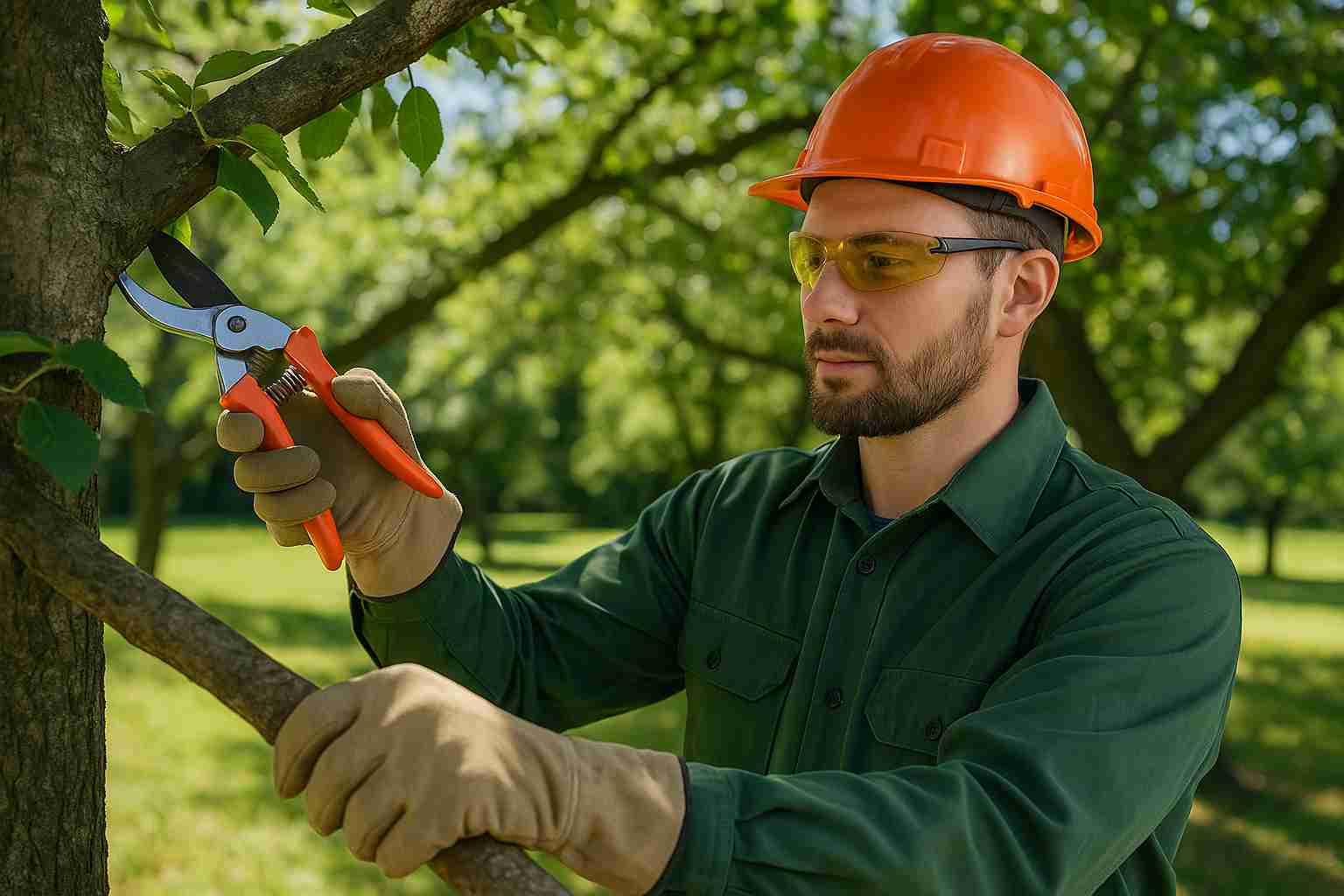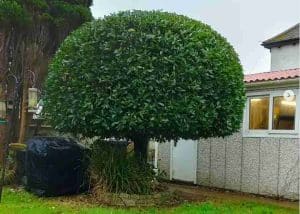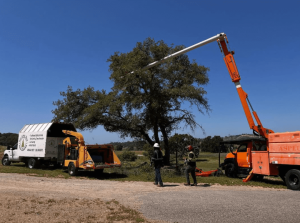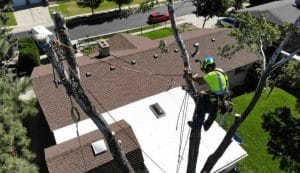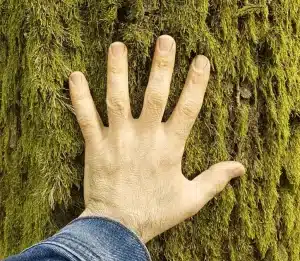Tree trimming focuses on shaping and maintaining a tree’s appearance, while tree pruning targets its health by removing dead, diseased, or weak branches. Although these two terms are often used interchangeably, they serve very different purposes. Trimming keeps your landscape neat and safe from overgrown limbs, while pruning strengthens trees from within to promote long-term growth and stability.
In this guide, you’ll learn the real difference between tree trimming and pruning, the best time to perform each, and how proper care helps prevent damage, improve curb appeal, and keep your trees thriving all year long.
Table of Contents
Why Tree Care Is Essential
Trees do more than make your yard look good. They provide shade, improve air quality, and can boost your home’s value. However, neglected trees can become hazards overgrown branches might fall during storms, or diseased limbs could harm nearby plants. Proper care keeps your trees healthy, safe, and attractive.
Trimming and pruning are two key methods to achieve this. Each serves a unique purpose, solving specific problems to ensure your trees thrive. Let’s explore what each one means and how they help you maintain a beautiful, worry-free yard.
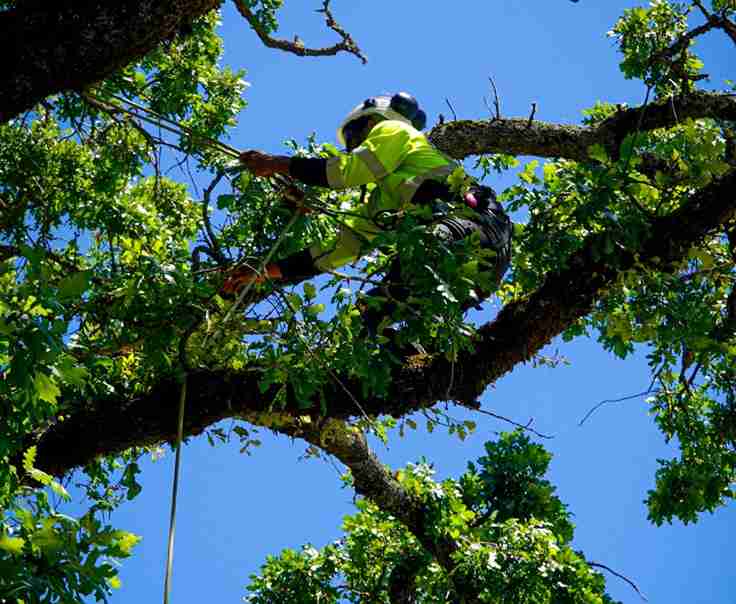
What Is Tree Trimming?
Tree trimming is the process of cutting back overgrown or excess branches to maintain a tree’s shape, safety, and visual appeal. It’s primarily done to keep trees neat, balanced, and away from structures or power lines. Regular trimming prevents branches from becoming hazards during storms and allows more sunlight to reach your yard or garden. Most trees benefit from trimming in late winter or early spring, when growth is dormant and cuts heal faster. Use clean, sharp shears to make 45° cuts just above buds, and avoid removing more than 25% of the canopy at once. After trimming, clear away debris to prevent pests and promote healthy regrowth.
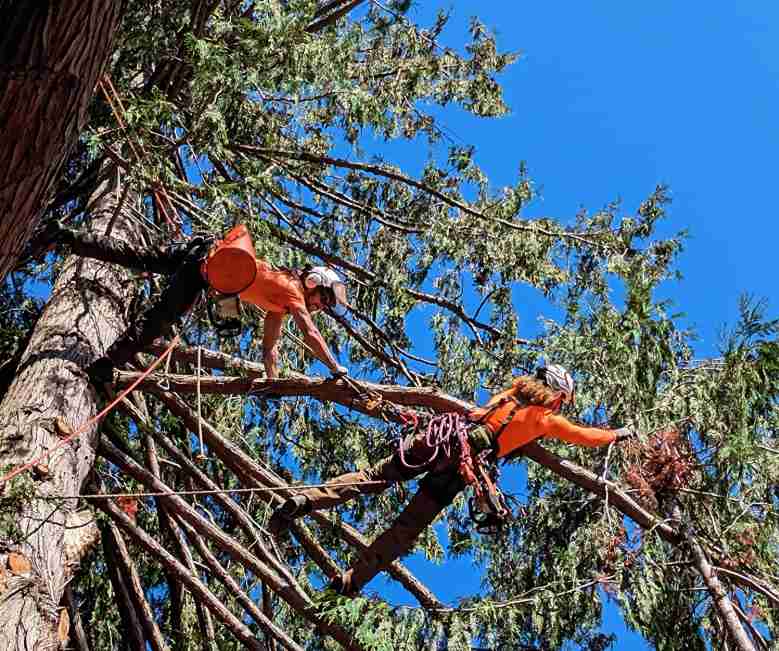
What Is Tree Pruning?
Tree pruning is the careful removal of dead, diseased, or weak branches to improve a tree’s overall health, structure, and longevity. Unlike trimming, which focuses on appearance, pruning targets internal growth to strengthen the tree and prevent damage or disease from spreading. Pruning helps redirect nutrients to healthy limbs, encourages better airflow, and shapes young trees for balanced, stable growth. The best time to prune is usually late winter or early spring, before new growth begins, although some species like fruit trees benefit from seasonal pruning to boost production. Always use clean, sharp pruners or saws to make precise cuts just outside the branch collar, and never over prune, as removing too much at once can stress the tree and slow recovery.
How Trimming and Pruning Differ
To clear up any confusion, here’s a side-by-side look at trimming versus pruning:
| Aspect | Tree Trimming | Tree Pruning |
|---|---|---|
| Purpose | Enhances appearance and ensures safety | Improves health and guides structure |
| What’s Cut | Overgrown, dead, or obstructive branches | Diseased, weak, or specific growth areas |
| Goal | Improve looks and clear space | Promote health and shape future growth |
| Tools Used | Shears, loppers, or saws | Precision pruners or saws |
| Frequency | Often annual or as needed | Done selectively, every 1-3 years |
For instance, trimming an oak tree’s branches that block your view improves aesthetics. Pruning the same tree to remove a diseased limb stops the disease from spreading. Knowing these differences helps you choose the right approach for your trees’ needs.
Why Getting It Right Pays Off
Trimming and pruning deliver results that go beyond a nice-looking yard. Here’s how they solve problems and benefit you:
- Safer Property: Trimming removes risky branches, while pruning prevents weak limbs from forming, lowering the chance of storm-related damage.
- Healthier Trees: Pruning catches diseases early, and trimming prevents overcrowding, helping trees live longer and thrive.
- Improved Curb Appeal: Well-trimmed trees look neat, and properly pruned trees grow strong and balanced, making your yard stand out.
- Increased Property Value: Healthy, attractive trees can boost your home’s value by up to 15%, according to research, making them a smart investment.
- Less Future Hassle: Regular care prevents bigger issues, like needing to remove an entire tree due to neglect, saving you time and money.
By focusing on both methods, you create a safer, more beautiful property with trees that last for years.
Mistakes to Avoid for Healthy Trees
Tree care can go wrong without the right approach. Here are common mistakes and how to steer clear of them:
- Cutting Too Much: Removing more than 25% of a tree’s canopy at once can stress it, inviting pests or disease. Stick to moderate cuts.
- Wrong Timing: Trimming or pruning during active growth periods can harm trees. Late winter or early spring is usually safest for most trees.
- Using Dull Tools: Dull blades tear branches, creating entry points for pests. Always use sharp, clean tools for smooth cuts.
- Ignoring Tree Type: Each tree has unique needs. For example, pine trees differ from fruit trees in care requirements. Research your tree’s specifics.
- Skipping Safety: Climbing ladders or using chainsaws without experience can lead to injuries. For risky jobs, consider professional help.
Avoiding these pitfalls ensures your trees stay healthy and your efforts are effective.
Signs Your Trees Need Care
Knowing when your trees need attention can prevent costly damage and keep them healthy year-round. If you’re wondering how to know if your tree needs pruning or trimming, start by looking for a few common warning signs of unhealthy trees. Branches that rub together, hang too low, or touch your roof or power lines are clear indicators that it’s time for trimming. Cracked or broken limbs, especially after storms, suggest pruning is needed to remove damaged wood and prevent decay.
Other signs include yellowing leaves, sparse foliage, or fungus growth around the base or trunk, which often point to disease or root stress. If the canopy looks overly dense or you notice dead limbs that don’t produce new growth, pruning can improve airflow and sunlight penetration. After severe weather, inspect your trees for storm damage and trim weak branches immediately to prevent further breakage or safety hazards.
Regularly checking for these issues ensures your trees stay strong, attractive, and safe for years to come.
Should You DIY or Hire a Pro?
Deciding whether to trim or prune yourself or hire help depends on the job. Here’s a breakdown to help you choose:
DIY Tree Care
- Pros: Saves money, offers control, and is rewarding for small tasks like trimming low branches or pruning young trees.
- Cons: Requires knowledge, proper tools, and safety know-how. Mistakes can damage trees or cause injuries.
- Best For: Small trees or minor jobs you feel confident handling.
Hiring a Professional
- Pros: Experts understand tree types, use precise techniques, and safely handle tricky tasks. They also spot hidden issues.
- Cons: Costs more, but it’s worth it for complex or risky jobs.
- Best For: Large trees, diseased trees, or tasks involving heights or heavy tools.
For big or complicated jobs, professionals are often the safer bet. For DIY, start with small tasks and ensure you have the right tools and knowledge.
Tips for Ongoing Tree Health
Keep your trees thriving with these practical habits:
- Regular Inspections: Check trees each season for signs of damage, pests, or disease.
- Proper Watering and Mulching: Young trees need consistent water and mulch to retain moisture and protect roots.
- Smart Fertilizing: Use the right fertilizer for your tree type, but avoid over-fertilizing to prevent harm.
- Combine Trimming and Pruning: Use both methods as needed—trim for aesthetics, prune for health—to keep trees in top shape.
- Stay Informed: Tree care varies by region and species. Research your trees’ specific needs for the best results.
Consistent care prevents problems and keeps your trees vibrant year-round.
The Rewards of Proper Tree Care
Trimming and pruning do more than maintain your trees—they transform your yard. Healthy trees are less likely to cause damage, like a branch crashing through your roof during a storm. They grow stronger, live longer, and add value to your property. For fruit trees, pruning can lead to bigger, better harvests. A well-cared-for yard feels welcoming and boosts your pride as a homeowner.
Picture a yard where every tree looks vibrant, with no overgrown branches or weak limbs. That’s the result of understanding and applying trimming and pruning correctly. By addressing your trees’ needs, you prevent issues and create a space you love.
Final Thoughts
Tree trimming and pruning are powerful tools for keeping your yard safe, healthy, and beautiful. Trimming enhances appearance and prevents hazards, while pruning promotes health and guides growth. By spotting signs of trouble and acting at the right time, you can avoid costly problems and enjoy stunning trees for years. Whether you tackle small tasks yourself or hire a pro for bigger jobs, the key is taking action. Start by inspecting your trees today and planning their care. Your trees and your property will thrive as a result!

FAQs
What is the difference between tree trimming and pruning?
Tree trimming focuses on cutting back overgrown branches to shape the tree and improve its appearance. Pruning involves removing dead or diseased branches to enhance the tree’s health and growth. Both are important for maintaining safe and healthy trees.
When is the best time to trim or prune trees?
The ideal time to trim or prune most trees is during late winter or early spring when trees are dormant. This timing helps prevent disease and encourages healthy growth. However, flowering trees should be pruned right after they bloom to avoid cutting off future flowers.
Why should I regularly trim or prune my trees?
Regular trimming and pruning keep trees healthy, prevent the spread of disease, and reduce the risk of falling branches. These practices also enhance the tree’s appearance and can increase property value by improving curb appeal.
Can trimming or pruning trees improve fruit or flower production?
Yes, proper pruning can stimulate better fruit and flower production by removing weak or overcrowded branches. This allows the tree to focus energy on producing healthy blooms and fruits.
Is it safe to trim or prune trees myself?
For small trees and minor cuts, DIY trimming or pruning can be safe if you use the right tools and techniques. However, for large trees or branches near power lines, it’s best to hire a professional to avoid injury or property damage.
How often should trees be trimmed or pruned?
Most trees benefit from trimming or pruning every 1 to 3 years, depending on the species and growth rate. Regular maintenance helps keep trees healthy and prevents potential hazards.
What are signs that a tree needs trimming or pruning?
Signs include dead or broken branches, branches growing too close to power lines or structures, and a dense canopy that blocks sunlight. Regular inspections can help identify these issues early.
Does trimming or pruning trees increase property value?
Yes, well-maintained trees enhance the landscape’s appearance, which can boost property value by up to 15%. Healthy trees also indicate proper care, appealing to potential buyers.
Can I trim and prune a tree at the same time?
Yes, but it’s important to plan carefully. Light trimming for shape can be done anytime, while pruning for health should be done during the dormant season.
What happens if you don’t prune trees?
Neglecting pruning can lead to weak, overcrowded branches that may break during storms, spread disease, or stunt the tree’s growth.
Is it okay to prune trees in summer?
Light pruning is fine in summer, but avoid heavy cuts since it can expose trees to heat stress and pests.
What tools are best for trimming and pruning?
Use clean, sharp tools such as hand pruners, loppers, pruning saws, or pole pruners. Sanitize blades between cuts to prevent spreading disease.
Should I hire a professional for tree pruning?
Yes, for large trees, difficult-to-reach branches, or diseased limbs, it’s safest to hire a certified arborist who can prune correctly and safely.
